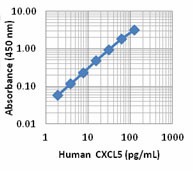- Regulatory Status
- RUO
- Other Names
- Epithelial neutrophil-activating protein (ENA78), granulocyte chemotactic protein-2 (GCP-2), alveolar macrophage chemotactic factor-II (AMCF-II)
- Ave. Rating
- Submit a Review
- Product Citations
- publications

| Cat # | Size | Price | Quantity Check Availability | Save | ||
|---|---|---|---|---|---|---|
| 573409 | 4 pack | £65 | ||||
CXCL5 is a member of the CXC family of chemokines, also known as epithelial activated peptide 78 (ENA-78). The precursor of CXCL5 contains 114 amino acids, with a signal peptide of 36 amino acids which is cleaved to generate the 78 amino acid mature protein (8 kD). CXCL5 is expressed by monocytes/macrophages, endothelial cells, vascular smooth muscle cells, epithilial cells, and eosinophils. CXCL5 is an inflammatory cytokine which binds to the cell surface receptor CXCR2 and induces chemotaxis of neutrophils to a target site. High levels of CXCL5 have been associated with prostate, gastric, and pancreatic cancer progression.
Product DetailsProduct Details
- Source
- Human CXCL5, amino acids Ala37-Asn114 (Accession# NM_002994.3), was expressed in E. coli.
- Molecular Mass
- The 78 amino acid recombinant protein has a predicted molecular mass of approximately 8.35 kD. The DTT-reduced and non-reduced protein migrate at approximately 10 kD by SDS-PAGE. The N-terminal amino acid is Ala.
- Purity
- >98%, as determined by Coomassie stained SDS-PAGE.
- Formulation
- Lyophilized in sterile-filtered PBS, pH 7.2, containing 1% BSA, 0.09% sodium azide, and protease inhibitors.
- Endotoxin Level
- Less than 0.01 ng per µg cytokine as determined by the LAL method.
- Concentration
- Lot-specific (to obtain lot-specific concentration and expiration, please enter the lot number in our Certificate of Analysis online tool.)
- Storage & Handling
- Unopened vials can be stored between 2°C and 8°C until the expiration date. Prior to use, reconstitute the lyophilized powder with 0.2 mL of PBS containing a carrier protein (e.g., 1% BSA, protease free), pH7.4. Re-cap vial, vortex. Allow the reconstituted standard to sit at room temperature for 15 minutes, vortex again to mix completely. The reconstituted standard stock solution can be aliquoted into polypropylene vials and stored at -70°C for up to one month. Do not re-use diluted standards. Avoid repeated freeze/thaw cycles.
- Application
-
ELISA - Quality tested
- Recommended Usage
-
Each lot of this protein is quality control tested by ELISA assay. For use as an ELISA standard, a standard curve comprised of two-fold dilutions from 125 pg/mL to 2 pg/mL are suggested. It is recommended that the reagent be titrated for optimal performance for each application.
- Application Notes
-
To measure human CXCL5, this recombinant protein can be used as a standard in a sandwich ELISA format, when used in conjunction with the purified J1119G12 antibody (Cat. No. 526202) as the capture antibody and the biotinylated J1119D2 antibody (Cat. No. 526304) as the detection antibody.
Note: For measuring human CXCL5 in serum, plasma or cell culture supernatant, LEGEND MAX™ Human CXCL5 ELISA Kit with Pre-coated Plates (Cat. No. 440907 & 440908) is specially developed and recommended.
Antigen Details
- Structure
- Chemokine
- Distribution
-
Endothelial cells, fibroblasts, neutrophils, monocytes, macrophages, platelets, alveolar type II cells
- Function
- CXCL5 chemoattracts and activates neutrophils during inflammation, and it is induced by LPS and inflammatory cytokines. NH2-terminal truncation enhances, whereas citrullination decreases the chemotactic properties of CXCL5.
- Ligand/Receptor
- CXCR2
- Biology Area
- Immunology, Innate Immunity
- Molecular Family
- Cytokines/Chemokines
- Antigen References
-
1. Walz A, et al. 1991. J. Exp. Med. 174:1355.
2. Wuyts A, et al. 1999. J. Immunol. 163:6155.
3. Jeyaseelan S, et al. 2005. Am. J. Respir. Cell. Mol. Biol. 32:531.
4. Mei J, et al. 2010. Immunity 33:106.
5. Mortier A, et al. 2010. J. Biol. Chem. 285:29750.
6. Grommes J and Soehnlein O. 2011. Mol. Med. 17:293.
7. Liu Y, et al. 2011. J. Immunol. 186:3197.
8. Kuo PL, et al. 2011. J. Cell. Physiol. 226:1224. - Gene ID
- 6374 View all products for this Gene ID
- UniProt
- View information about CXCL5 on UniProt.org
 Login / Register
Login / Register 
















Follow Us